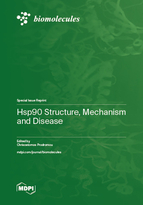Hsp90 Structure, Mechanism and Disease
A special issue of Biomolecules (ISSN 2218-273X).
Deadline for manuscript submissions: closed (15 August 2022) | Viewed by 45806
Special Issue Editor
Special Issue Information
Dear Colleagues,
The Hsp90 chaperone complex is responsible for the activation and maturation of a vast array of signaling proteins. Recently, there has been a leap in our understanding of the structure and molecular mechanisms involved in such regulation. This has opened a doorway into underlying mechanisms of disease processes and how we may intervene in such mechanisms to improve prognosis.
The focus of this Special Issue of Biomolecules will be on recent structural and biochemical advances of Hsp90 that provide insights into the mechanistic activation of client proteins. It will include discussions on the development of small molecules against Hsp90 and its co-chaperones and their potential as therapeutic agents against a variety of human diseases. Discussions on mechanisms leading to disease are encouraged. Both research and review articles are welcome.
Dr. Chrisostomos Prodromou
Guest Editor
Manuscript Submission Information
Manuscripts should be submitted online at www.mdpi.com by registering and logging in to this website. Once you are registered, click here to go to the submission form. Manuscripts can be submitted until the deadline. All submissions that pass pre-check are peer-reviewed. Accepted papers will be published continuously in the journal (as soon as accepted) and will be listed together on the special issue website. Research articles, review articles as well as short communications are invited. For planned papers, a title and short abstract (about 100 words) can be sent to the Editorial Office for announcement on this website.
Submitted manuscripts should not have been published previously, nor be under consideration for publication elsewhere (except conference proceedings papers). All manuscripts are thoroughly refereed through a single-blind peer-review process. A guide for authors and other relevant information for submission of manuscripts is available on the Instructions for Authors page. Biomolecules is an international peer-reviewed open access monthly journal published by MDPI.
Please visit the Instructions for Authors page before submitting a manuscript. The Article Processing Charge (APC) for publication in this open access journal is 2700 CHF (Swiss Francs). Submitted papers should be well formatted and use good English. Authors may use MDPI's English editing service prior to publication or during author revisions.
Keywords
- Hsp90
- heat shock proteins
- chaperone
- structure
- mechanism
- regulation
- disease
- cancer
- neurological disease
- drug development







